OHS6205 - Hazardous Chemical Risk Assessment and Management Report
VerifiedAdded on 2022/09/18
|14
|3530
|21
Report
AI Summary
This report, prepared for senior management, presents a comprehensive analysis of the hazards associated with bleach (sodium hypochlorite) in a workplace setting. It begins with an abstract summarizing the study's objectives, which include assessing risks, suggesting control measures, and implementing a management system to mitigate potential dangers to workers. The report delves into the properties of bleach, its health hazards (including skin and eye irritation, and potential respiratory issues), and the importance of proper hazardous chemical management. It identifies the chemical, assesses its effects, and provides detailed recommendations for industrial and workplace safety, including engineering, environmental, and personal protective controls. A task observation and risk assessment, conducted on August 25, 2019, highlights both healthy and ill practices, offering insights into the current management's effectiveness. The report concludes by emphasizing the benefits of a robust hazardous chemical management system to ensure a safe and productive work environment. The report also includes the benefits of hazardous chemical management, providing insights on the recycling and treatment methods like cement-based solidification, incineration, and landfill management, along with discussing the identification of the substance and its health effects.
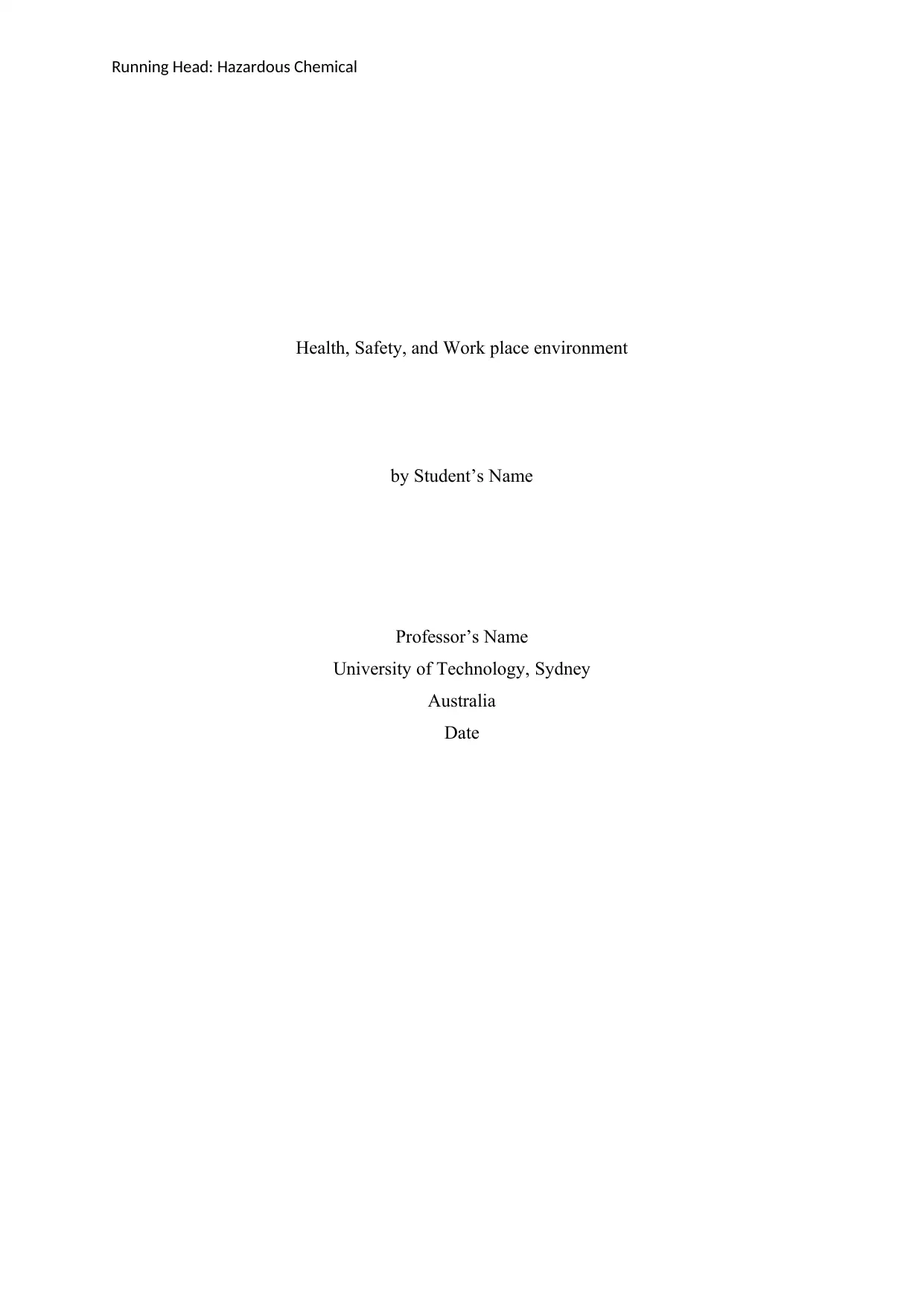
Running Head: Hazardous Chemical
Health, Safety, and Work place environment
by Student’s Name
Professor’s Name
University of Technology, Sydney
Australia
Date
Health, Safety, and Work place environment
by Student’s Name
Professor’s Name
University of Technology, Sydney
Australia
Date
Paraphrase This Document
Need a fresh take? Get an instant paraphrase of this document with our AI Paraphraser
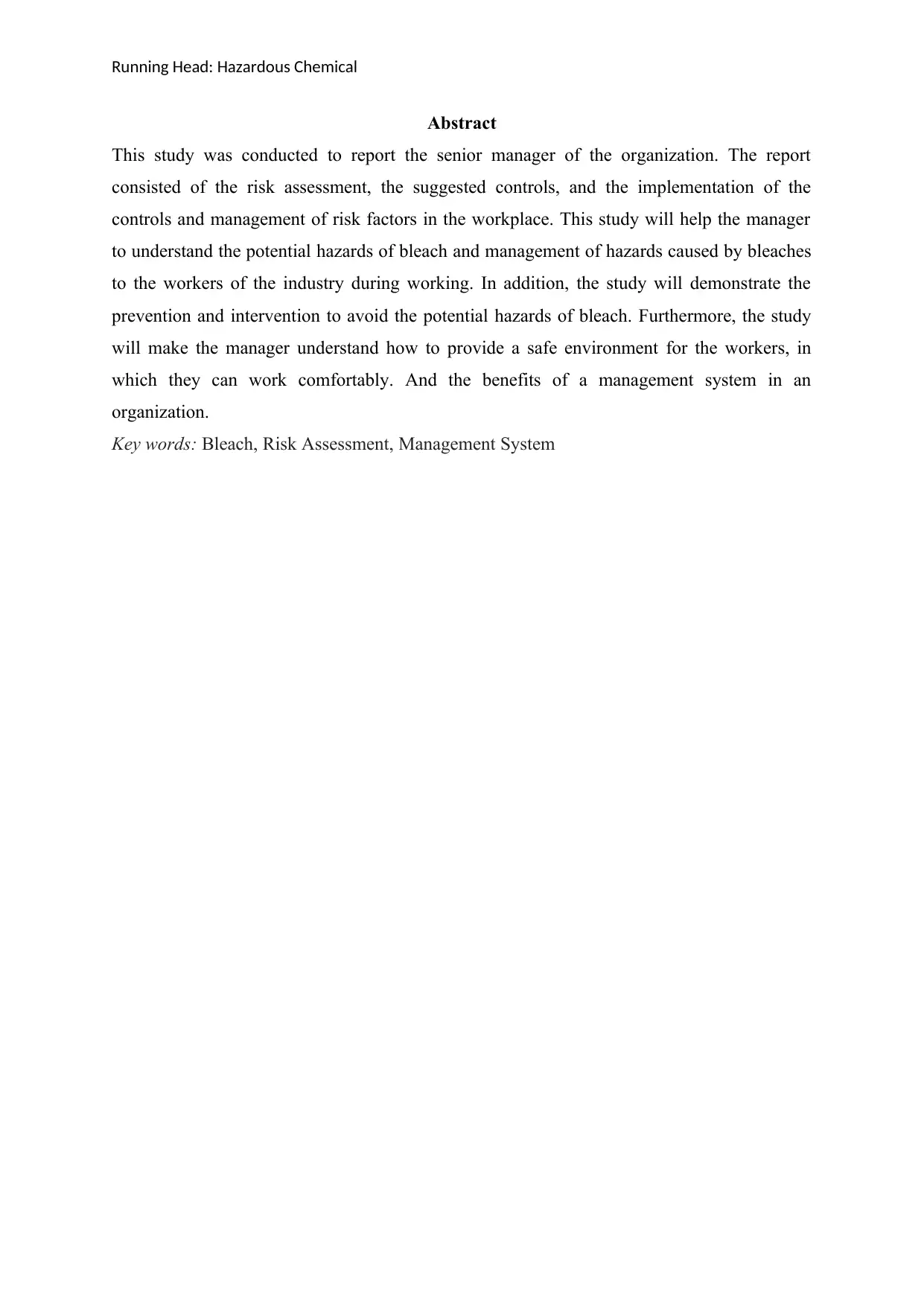
Running Head: Hazardous Chemical
Abstract
This study was conducted to report the senior manager of the organization. The report
consisted of the risk assessment, the suggested controls, and the implementation of the
controls and management of risk factors in the workplace. This study will help the manager
to understand the potential hazards of bleach and management of hazards caused by bleaches
to the workers of the industry during working. In addition, the study will demonstrate the
prevention and intervention to avoid the potential hazards of bleach. Furthermore, the study
will make the manager understand how to provide a safe environment for the workers, in
which they can work comfortably. And the benefits of a management system in an
organization.
Key words: Bleach, Risk Assessment, Management System
Abstract
This study was conducted to report the senior manager of the organization. The report
consisted of the risk assessment, the suggested controls, and the implementation of the
controls and management of risk factors in the workplace. This study will help the manager
to understand the potential hazards of bleach and management of hazards caused by bleaches
to the workers of the industry during working. In addition, the study will demonstrate the
prevention and intervention to avoid the potential hazards of bleach. Furthermore, the study
will make the manager understand how to provide a safe environment for the workers, in
which they can work comfortably. And the benefits of a management system in an
organization.
Key words: Bleach, Risk Assessment, Management System
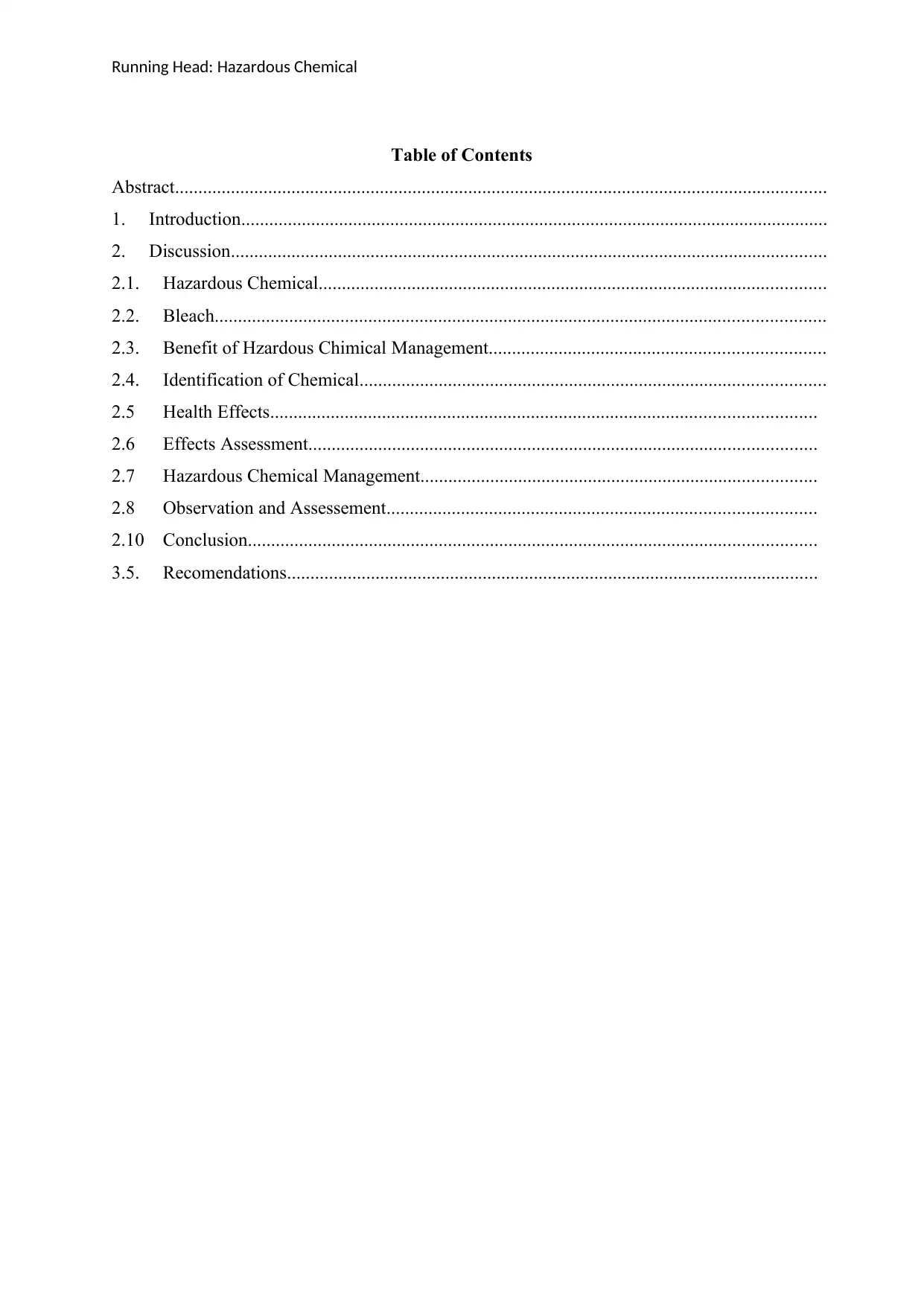
Running Head: Hazardous Chemical
Table of Contents
Abstract............................................................................................................................................
1. Introduction..............................................................................................................................
2. Discussion................................................................................................................................
2.1. Hazardous Chemical.............................................................................................................
2.2. Bleach...................................................................................................................................
2.3. Benefit of Hzardous Chimical Management........................................................................
2.4. Identification of Chemical....................................................................................................
2.5 Health Effects.....................................................................................................................
2.6 Effects Assessment.............................................................................................................
2.7 Hazardous Chemical Management.....................................................................................
2.8 Observation and Assessement............................................................................................
2.10 Conclusion..........................................................................................................................
3.5. Recomendations..................................................................................................................
Table of Contents
Abstract............................................................................................................................................
1. Introduction..............................................................................................................................
2. Discussion................................................................................................................................
2.1. Hazardous Chemical.............................................................................................................
2.2. Bleach...................................................................................................................................
2.3. Benefit of Hzardous Chimical Management........................................................................
2.4. Identification of Chemical....................................................................................................
2.5 Health Effects.....................................................................................................................
2.6 Effects Assessment.............................................................................................................
2.7 Hazardous Chemical Management.....................................................................................
2.8 Observation and Assessement............................................................................................
2.10 Conclusion..........................................................................................................................
3.5. Recomendations..................................................................................................................
⊘ This is a preview!⊘
Do you want full access?
Subscribe today to unlock all pages.

Trusted by 1+ million students worldwide
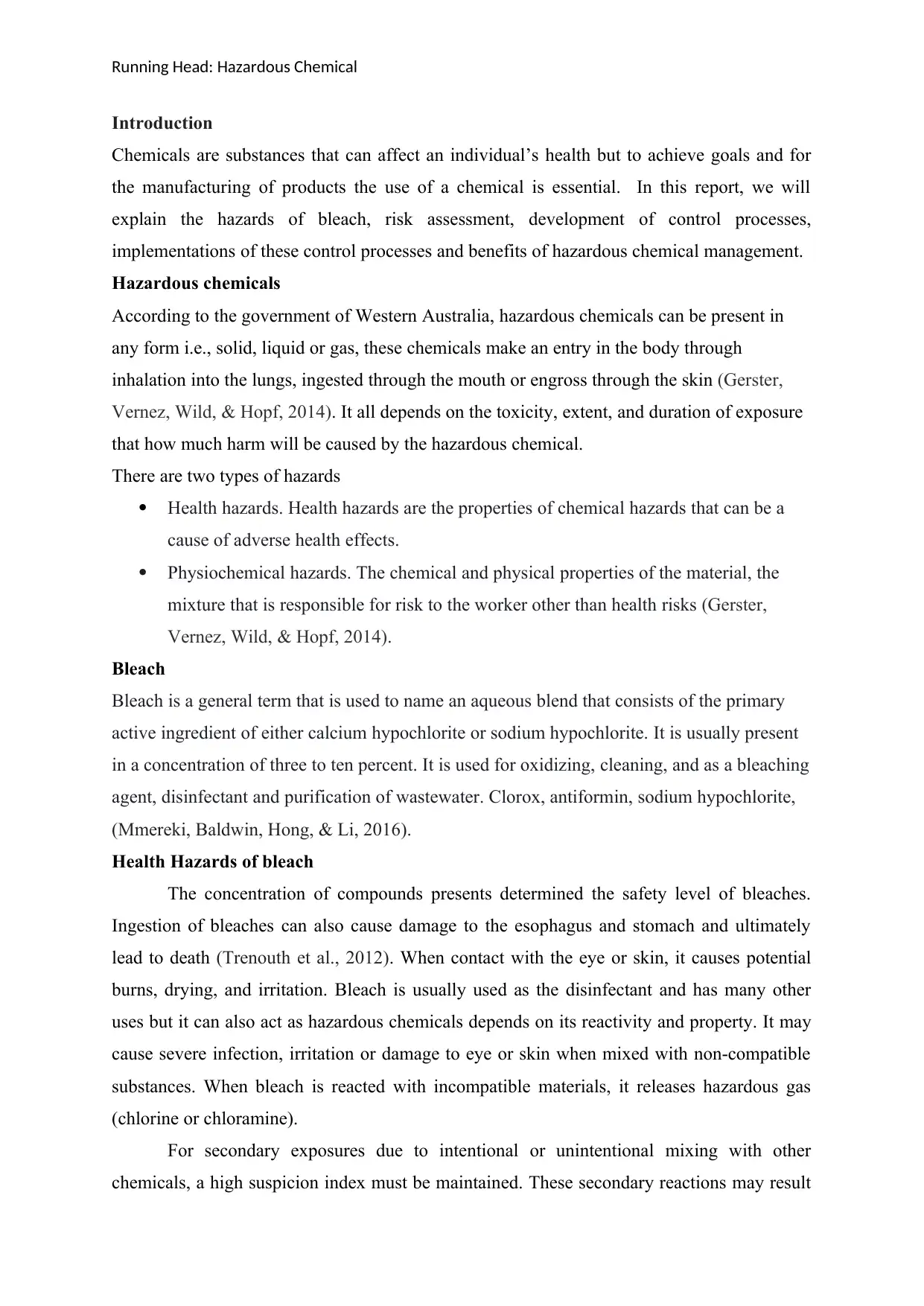
Running Head: Hazardous Chemical
Introduction
Chemicals are substances that can affect an individual’s health but to achieve goals and for
the manufacturing of products the use of a chemical is essential. In this report, we will
explain the hazards of bleach, risk assessment, development of control processes,
implementations of these control processes and benefits of hazardous chemical management.
Hazardous chemicals
According to the government of Western Australia, hazardous chemicals can be present in
any form i.e., solid, liquid or gas, these chemicals make an entry in the body through
inhalation into the lungs, ingested through the mouth or engross through the skin (Gerster,
Vernez, Wild, & Hopf, 2014). It all depends on the toxicity, extent, and duration of exposure
that how much harm will be caused by the hazardous chemical.
There are two types of hazards
Health hazards. Health hazards are the properties of chemical hazards that can be a
cause of adverse health effects.
Physiochemical hazards. The chemical and physical properties of the material, the
mixture that is responsible for risk to the worker other than health risks (Gerster,
Vernez, Wild, & Hopf, 2014).
Bleach
Bleach is a general term that is used to name an aqueous blend that consists of the primary
active ingredient of either calcium hypochlorite or sodium hypochlorite. It is usually present
in a concentration of three to ten percent. It is used for oxidizing, cleaning, and as a bleaching
agent, disinfectant and purification of wastewater. Clorox, antiformin, sodium hypochlorite,
(Mmereki, Baldwin, Hong, & Li, 2016).
Health Hazards of bleach
The concentration of compounds presents determined the safety level of bleaches.
Ingestion of bleaches can also cause damage to the esophagus and stomach and ultimately
lead to death (Trenouth et al., 2012). When contact with the eye or skin, it causes potential
burns, drying, and irritation. Bleach is usually used as the disinfectant and has many other
uses but it can also act as hazardous chemicals depends on its reactivity and property. It may
cause severe infection, irritation or damage to eye or skin when mixed with non-compatible
substances. When bleach is reacted with incompatible materials, it releases hazardous gas
(chlorine or chloramine).
For secondary exposures due to intentional or unintentional mixing with other
chemicals, a high suspicion index must be maintained. These secondary reactions may result
Introduction
Chemicals are substances that can affect an individual’s health but to achieve goals and for
the manufacturing of products the use of a chemical is essential. In this report, we will
explain the hazards of bleach, risk assessment, development of control processes,
implementations of these control processes and benefits of hazardous chemical management.
Hazardous chemicals
According to the government of Western Australia, hazardous chemicals can be present in
any form i.e., solid, liquid or gas, these chemicals make an entry in the body through
inhalation into the lungs, ingested through the mouth or engross through the skin (Gerster,
Vernez, Wild, & Hopf, 2014). It all depends on the toxicity, extent, and duration of exposure
that how much harm will be caused by the hazardous chemical.
There are two types of hazards
Health hazards. Health hazards are the properties of chemical hazards that can be a
cause of adverse health effects.
Physiochemical hazards. The chemical and physical properties of the material, the
mixture that is responsible for risk to the worker other than health risks (Gerster,
Vernez, Wild, & Hopf, 2014).
Bleach
Bleach is a general term that is used to name an aqueous blend that consists of the primary
active ingredient of either calcium hypochlorite or sodium hypochlorite. It is usually present
in a concentration of three to ten percent. It is used for oxidizing, cleaning, and as a bleaching
agent, disinfectant and purification of wastewater. Clorox, antiformin, sodium hypochlorite,
(Mmereki, Baldwin, Hong, & Li, 2016).
Health Hazards of bleach
The concentration of compounds presents determined the safety level of bleaches.
Ingestion of bleaches can also cause damage to the esophagus and stomach and ultimately
lead to death (Trenouth et al., 2012). When contact with the eye or skin, it causes potential
burns, drying, and irritation. Bleach is usually used as the disinfectant and has many other
uses but it can also act as hazardous chemicals depends on its reactivity and property. It may
cause severe infection, irritation or damage to eye or skin when mixed with non-compatible
substances. When bleach is reacted with incompatible materials, it releases hazardous gas
(chlorine or chloramine).
For secondary exposures due to intentional or unintentional mixing with other
chemicals, a high suspicion index must be maintained. These secondary reactions may result
Paraphrase This Document
Need a fresh take? Get an instant paraphrase of this document with our AI Paraphraser
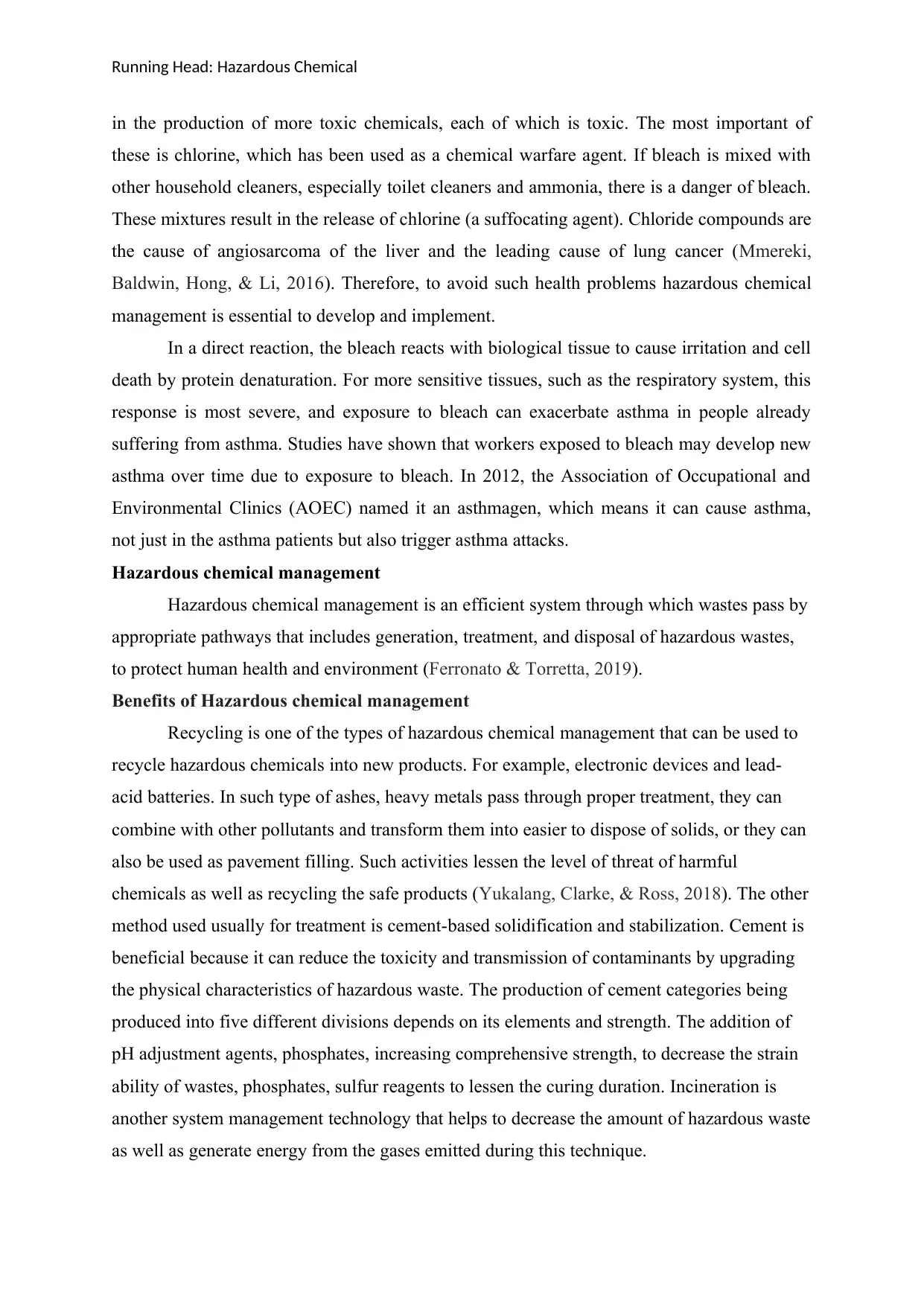
Running Head: Hazardous Chemical
in the production of more toxic chemicals, each of which is toxic. The most important of
these is chlorine, which has been used as a chemical warfare agent. If bleach is mixed with
other household cleaners, especially toilet cleaners and ammonia, there is a danger of bleach.
These mixtures result in the release of chlorine (a suffocating agent). Chloride compounds are
the cause of angiosarcoma of the liver and the leading cause of lung cancer (Mmereki,
Baldwin, Hong, & Li, 2016). Therefore, to avoid such health problems hazardous chemical
management is essential to develop and implement.
In a direct reaction, the bleach reacts with biological tissue to cause irritation and cell
death by protein denaturation. For more sensitive tissues, such as the respiratory system, this
response is most severe, and exposure to bleach can exacerbate asthma in people already
suffering from asthma. Studies have shown that workers exposed to bleach may develop new
asthma over time due to exposure to bleach. In 2012, the Association of Occupational and
Environmental Clinics (AOEC) named it an asthmagen, which means it can cause asthma,
not just in the asthma patients but also trigger asthma attacks.
Hazardous chemical management
Hazardous chemical management is an efficient system through which wastes pass by
appropriate pathways that includes generation, treatment, and disposal of hazardous wastes,
to protect human health and environment (Ferronato & Torretta, 2019).
Benefits of Hazardous chemical management
Recycling is one of the types of hazardous chemical management that can be used to
recycle hazardous chemicals into new products. For example, electronic devices and lead-
acid batteries. In such type of ashes, heavy metals pass through proper treatment, they can
combine with other pollutants and transform them into easier to dispose of solids, or they can
also be used as pavement filling. Such activities lessen the level of threat of harmful
chemicals as well as recycling the safe products (Yukalang, Clarke, & Ross, 2018). The other
method used usually for treatment is cement-based solidification and stabilization. Cement is
beneficial because it can reduce the toxicity and transmission of contaminants by upgrading
the physical characteristics of hazardous waste. The production of cement categories being
produced into five different divisions depends on its elements and strength. The addition of
pH adjustment agents, phosphates, increasing comprehensive strength, to decrease the strain
ability of wastes, phosphates, sulfur reagents to lessen the curing duration. Incineration is
another system management technology that helps to decrease the amount of hazardous waste
as well as generate energy from the gases emitted during this technique.
in the production of more toxic chemicals, each of which is toxic. The most important of
these is chlorine, which has been used as a chemical warfare agent. If bleach is mixed with
other household cleaners, especially toilet cleaners and ammonia, there is a danger of bleach.
These mixtures result in the release of chlorine (a suffocating agent). Chloride compounds are
the cause of angiosarcoma of the liver and the leading cause of lung cancer (Mmereki,
Baldwin, Hong, & Li, 2016). Therefore, to avoid such health problems hazardous chemical
management is essential to develop and implement.
In a direct reaction, the bleach reacts with biological tissue to cause irritation and cell
death by protein denaturation. For more sensitive tissues, such as the respiratory system, this
response is most severe, and exposure to bleach can exacerbate asthma in people already
suffering from asthma. Studies have shown that workers exposed to bleach may develop new
asthma over time due to exposure to bleach. In 2012, the Association of Occupational and
Environmental Clinics (AOEC) named it an asthmagen, which means it can cause asthma,
not just in the asthma patients but also trigger asthma attacks.
Hazardous chemical management
Hazardous chemical management is an efficient system through which wastes pass by
appropriate pathways that includes generation, treatment, and disposal of hazardous wastes,
to protect human health and environment (Ferronato & Torretta, 2019).
Benefits of Hazardous chemical management
Recycling is one of the types of hazardous chemical management that can be used to
recycle hazardous chemicals into new products. For example, electronic devices and lead-
acid batteries. In such type of ashes, heavy metals pass through proper treatment, they can
combine with other pollutants and transform them into easier to dispose of solids, or they can
also be used as pavement filling. Such activities lessen the level of threat of harmful
chemicals as well as recycling the safe products (Yukalang, Clarke, & Ross, 2018). The other
method used usually for treatment is cement-based solidification and stabilization. Cement is
beneficial because it can reduce the toxicity and transmission of contaminants by upgrading
the physical characteristics of hazardous waste. The production of cement categories being
produced into five different divisions depends on its elements and strength. The addition of
pH adjustment agents, phosphates, increasing comprehensive strength, to decrease the strain
ability of wastes, phosphates, sulfur reagents to lessen the curing duration. Incineration is
another system management technology that helps to decrease the amount of hazardous waste
as well as generate energy from the gases emitted during this technique.
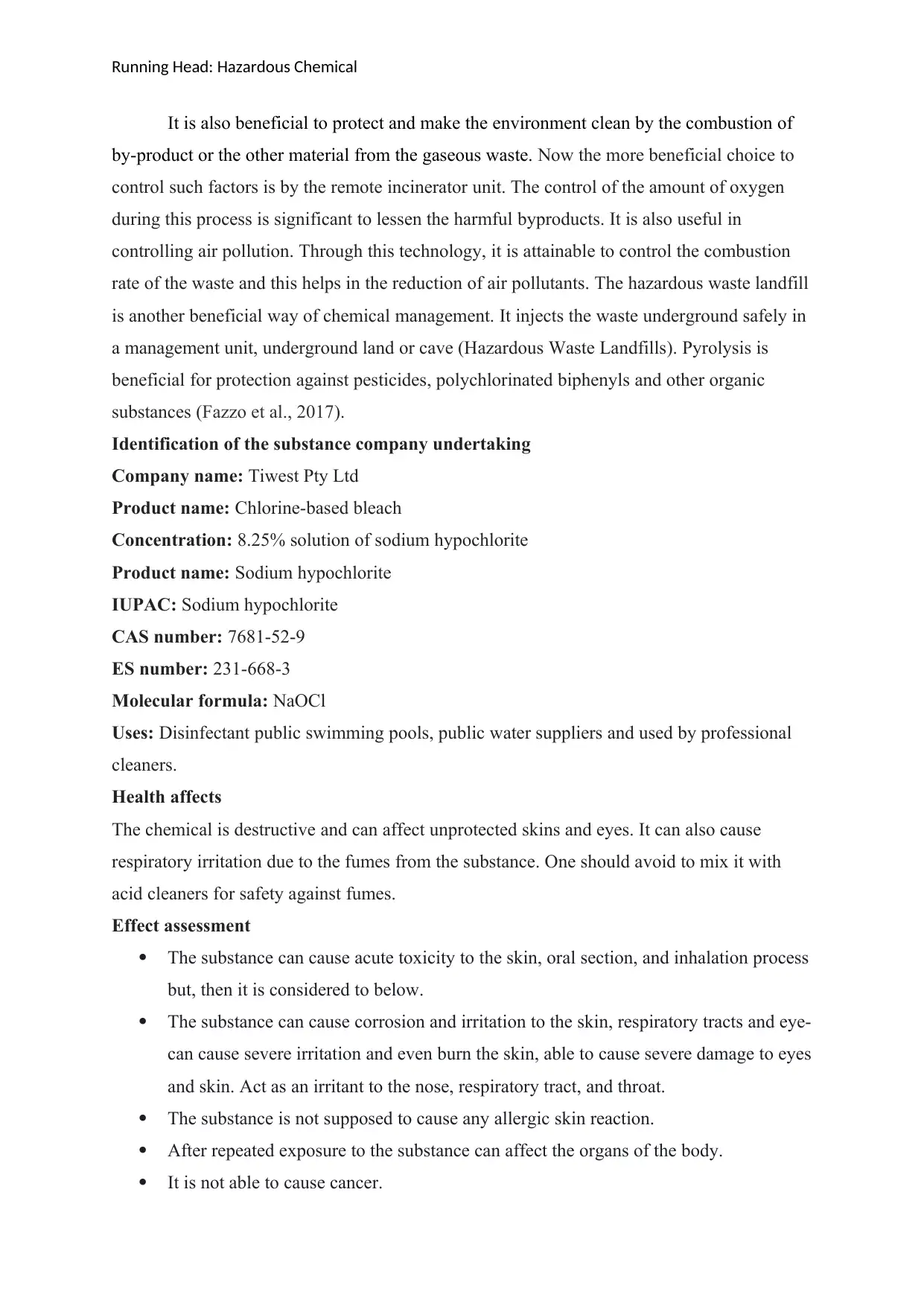
Running Head: Hazardous Chemical
It is also beneficial to protect and make the environment clean by the combustion of
by-product or the other material from the gaseous waste. Now the more beneficial choice to
control such factors is by the remote incinerator unit. The control of the amount of oxygen
during this process is significant to lessen the harmful byproducts. It is also useful in
controlling air pollution. Through this technology, it is attainable to control the combustion
rate of the waste and this helps in the reduction of air pollutants. The hazardous waste landfill
is another beneficial way of chemical management. It injects the waste underground safely in
a management unit, underground land or cave (Hazardous Waste Landfills). Pyrolysis is
beneficial for protection against pesticides, polychlorinated biphenyls and other organic
substances (Fazzo et al., 2017).
Identification of the substance company undertaking
Company name: Tiwest Pty Ltd
Product name: Chlorine-based bleach
Concentration: 8.25% solution of sodium hypochlorite
Product name: Sodium hypochlorite
IUPAC: Sodium hypochlorite
CAS number: 7681-52-9
ES number: 231-668-3
Molecular formula: NaOCl
Uses: Disinfectant public swimming pools, public water suppliers and used by professional
cleaners.
Health affects
The chemical is destructive and can affect unprotected skins and eyes. It can also cause
respiratory irritation due to the fumes from the substance. One should avoid to mix it with
acid cleaners for safety against fumes.
Effect assessment
The substance can cause acute toxicity to the skin, oral section, and inhalation process
but, then it is considered to below.
The substance can cause corrosion and irritation to the skin, respiratory tracts and eye-
can cause severe irritation and even burn the skin, able to cause severe damage to eyes
and skin. Act as an irritant to the nose, respiratory tract, and throat.
The substance is not supposed to cause any allergic skin reaction.
After repeated exposure to the substance can affect the organs of the body.
It is not able to cause cancer.
It is also beneficial to protect and make the environment clean by the combustion of
by-product or the other material from the gaseous waste. Now the more beneficial choice to
control such factors is by the remote incinerator unit. The control of the amount of oxygen
during this process is significant to lessen the harmful byproducts. It is also useful in
controlling air pollution. Through this technology, it is attainable to control the combustion
rate of the waste and this helps in the reduction of air pollutants. The hazardous waste landfill
is another beneficial way of chemical management. It injects the waste underground safely in
a management unit, underground land or cave (Hazardous Waste Landfills). Pyrolysis is
beneficial for protection against pesticides, polychlorinated biphenyls and other organic
substances (Fazzo et al., 2017).
Identification of the substance company undertaking
Company name: Tiwest Pty Ltd
Product name: Chlorine-based bleach
Concentration: 8.25% solution of sodium hypochlorite
Product name: Sodium hypochlorite
IUPAC: Sodium hypochlorite
CAS number: 7681-52-9
ES number: 231-668-3
Molecular formula: NaOCl
Uses: Disinfectant public swimming pools, public water suppliers and used by professional
cleaners.
Health affects
The chemical is destructive and can affect unprotected skins and eyes. It can also cause
respiratory irritation due to the fumes from the substance. One should avoid to mix it with
acid cleaners for safety against fumes.
Effect assessment
The substance can cause acute toxicity to the skin, oral section, and inhalation process
but, then it is considered to below.
The substance can cause corrosion and irritation to the skin, respiratory tracts and eye-
can cause severe irritation and even burn the skin, able to cause severe damage to eyes
and skin. Act as an irritant to the nose, respiratory tract, and throat.
The substance is not supposed to cause any allergic skin reaction.
After repeated exposure to the substance can affect the organs of the body.
It is not able to cause cancer.
⊘ This is a preview!⊘
Do you want full access?
Subscribe today to unlock all pages.

Trusted by 1+ million students worldwide
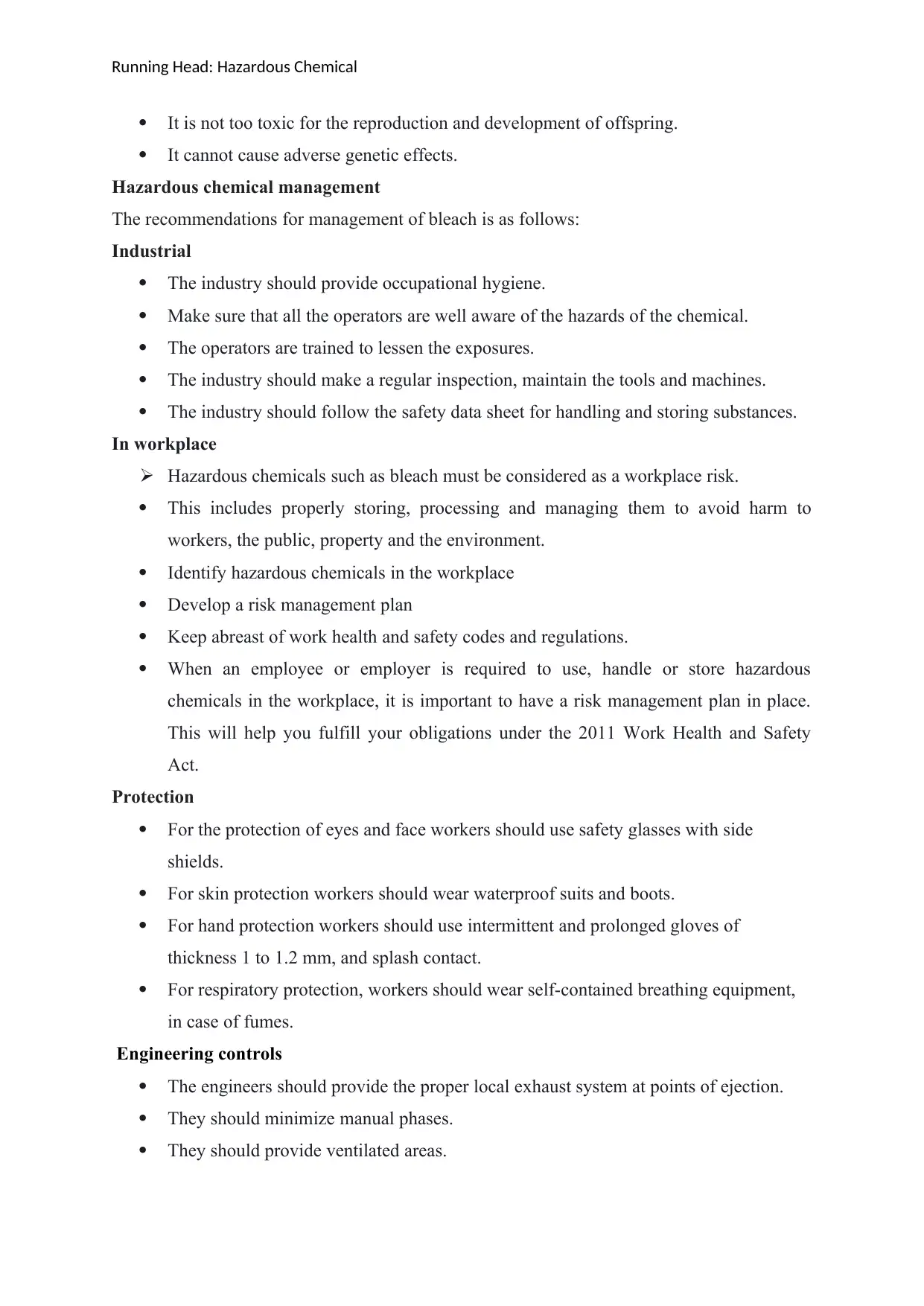
Running Head: Hazardous Chemical
It is not too toxic for the reproduction and development of offspring.
It cannot cause adverse genetic effects.
Hazardous chemical management
The recommendations for management of bleach is as follows:
Industrial
The industry should provide occupational hygiene.
Make sure that all the operators are well aware of the hazards of the chemical.
The operators are trained to lessen the exposures.
The industry should make a regular inspection, maintain the tools and machines.
The industry should follow the safety data sheet for handling and storing substances.
In workplace
Hazardous chemicals such as bleach must be considered as a workplace risk.
This includes properly storing, processing and managing them to avoid harm to
workers, the public, property and the environment.
Identify hazardous chemicals in the workplace
Develop a risk management plan
Keep abreast of work health and safety codes and regulations.
When an employee or employer is required to use, handle or store hazardous
chemicals in the workplace, it is important to have a risk management plan in place.
This will help you fulfill your obligations under the 2011 Work Health and Safety
Act.
Protection
For the protection of eyes and face workers should use safety glasses with side
shields.
For skin protection workers should wear waterproof suits and boots.
For hand protection workers should use intermittent and prolonged gloves of
thickness 1 to 1.2 mm, and splash contact.
For respiratory protection, workers should wear self-contained breathing equipment,
in case of fumes.
Engineering controls
The engineers should provide the proper local exhaust system at points of ejection.
They should minimize manual phases.
They should provide ventilated areas.
It is not too toxic for the reproduction and development of offspring.
It cannot cause adverse genetic effects.
Hazardous chemical management
The recommendations for management of bleach is as follows:
Industrial
The industry should provide occupational hygiene.
Make sure that all the operators are well aware of the hazards of the chemical.
The operators are trained to lessen the exposures.
The industry should make a regular inspection, maintain the tools and machines.
The industry should follow the safety data sheet for handling and storing substances.
In workplace
Hazardous chemicals such as bleach must be considered as a workplace risk.
This includes properly storing, processing and managing them to avoid harm to
workers, the public, property and the environment.
Identify hazardous chemicals in the workplace
Develop a risk management plan
Keep abreast of work health and safety codes and regulations.
When an employee or employer is required to use, handle or store hazardous
chemicals in the workplace, it is important to have a risk management plan in place.
This will help you fulfill your obligations under the 2011 Work Health and Safety
Act.
Protection
For the protection of eyes and face workers should use safety glasses with side
shields.
For skin protection workers should wear waterproof suits and boots.
For hand protection workers should use intermittent and prolonged gloves of
thickness 1 to 1.2 mm, and splash contact.
For respiratory protection, workers should wear self-contained breathing equipment,
in case of fumes.
Engineering controls
The engineers should provide the proper local exhaust system at points of ejection.
They should minimize manual phases.
They should provide ventilated areas.
Paraphrase This Document
Need a fresh take? Get an instant paraphrase of this document with our AI Paraphraser
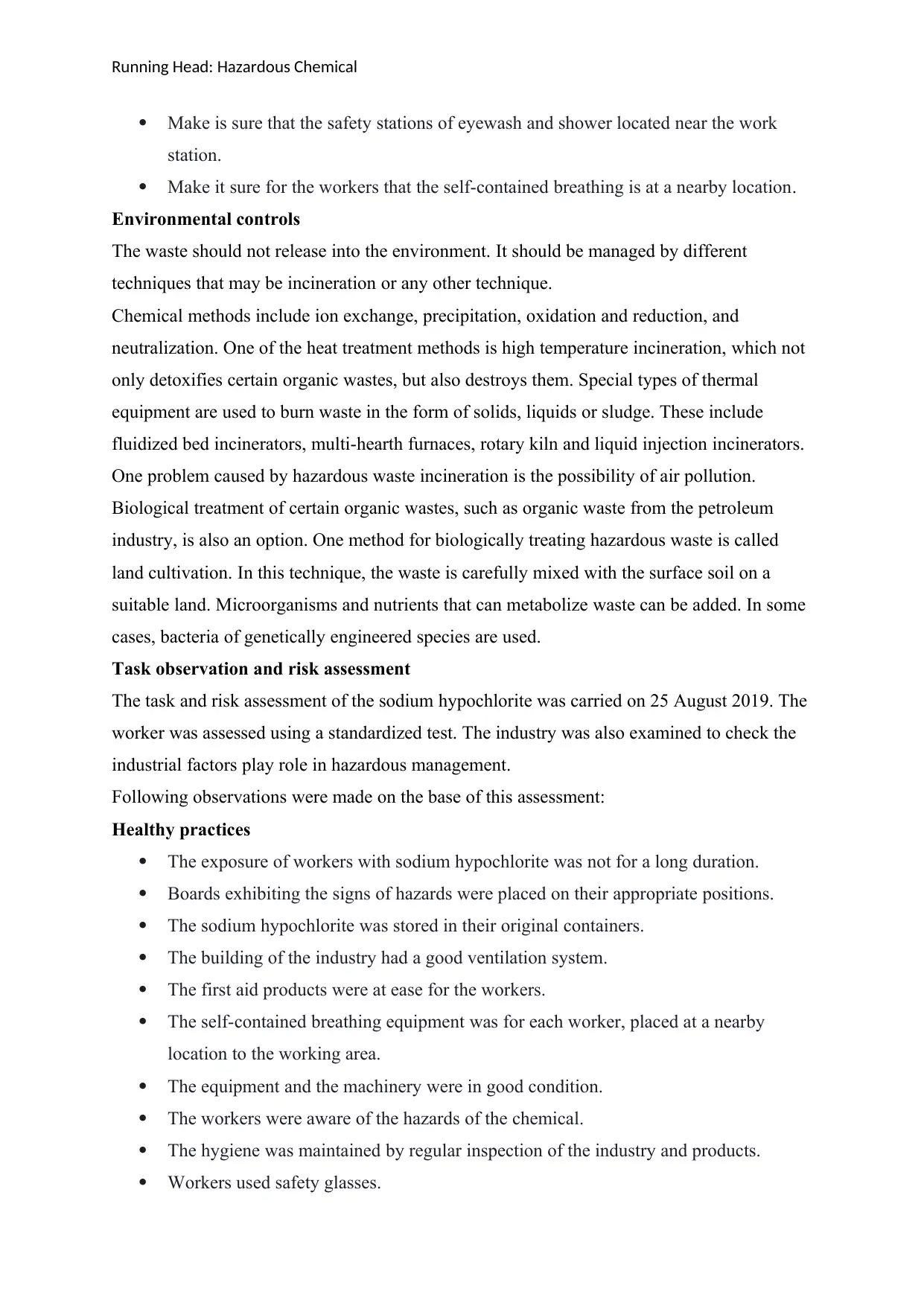
Running Head: Hazardous Chemical
Make is sure that the safety stations of eyewash and shower located near the work
station.
Make it sure for the workers that the self-contained breathing is at a nearby location.
Environmental controls
The waste should not release into the environment. It should be managed by different
techniques that may be incineration or any other technique.
Chemical methods include ion exchange, precipitation, oxidation and reduction, and
neutralization. One of the heat treatment methods is high temperature incineration, which not
only detoxifies certain organic wastes, but also destroys them. Special types of thermal
equipment are used to burn waste in the form of solids, liquids or sludge. These include
fluidized bed incinerators, multi-hearth furnaces, rotary kiln and liquid injection incinerators.
One problem caused by hazardous waste incineration is the possibility of air pollution.
Biological treatment of certain organic wastes, such as organic waste from the petroleum
industry, is also an option. One method for biologically treating hazardous waste is called
land cultivation. In this technique, the waste is carefully mixed with the surface soil on a
suitable land. Microorganisms and nutrients that can metabolize waste can be added. In some
cases, bacteria of genetically engineered species are used.
Task observation and risk assessment
The task and risk assessment of the sodium hypochlorite was carried on 25 August 2019. The
worker was assessed using a standardized test. The industry was also examined to check the
industrial factors play role in hazardous management.
Following observations were made on the base of this assessment:
Healthy practices
The exposure of workers with sodium hypochlorite was not for a long duration.
Boards exhibiting the signs of hazards were placed on their appropriate positions.
The sodium hypochlorite was stored in their original containers.
The building of the industry had a good ventilation system.
The first aid products were at ease for the workers.
The self-contained breathing equipment was for each worker, placed at a nearby
location to the working area.
The equipment and the machinery were in good condition.
The workers were aware of the hazards of the chemical.
The hygiene was maintained by regular inspection of the industry and products.
Workers used safety glasses.
Make is sure that the safety stations of eyewash and shower located near the work
station.
Make it sure for the workers that the self-contained breathing is at a nearby location.
Environmental controls
The waste should not release into the environment. It should be managed by different
techniques that may be incineration or any other technique.
Chemical methods include ion exchange, precipitation, oxidation and reduction, and
neutralization. One of the heat treatment methods is high temperature incineration, which not
only detoxifies certain organic wastes, but also destroys them. Special types of thermal
equipment are used to burn waste in the form of solids, liquids or sludge. These include
fluidized bed incinerators, multi-hearth furnaces, rotary kiln and liquid injection incinerators.
One problem caused by hazardous waste incineration is the possibility of air pollution.
Biological treatment of certain organic wastes, such as organic waste from the petroleum
industry, is also an option. One method for biologically treating hazardous waste is called
land cultivation. In this technique, the waste is carefully mixed with the surface soil on a
suitable land. Microorganisms and nutrients that can metabolize waste can be added. In some
cases, bacteria of genetically engineered species are used.
Task observation and risk assessment
The task and risk assessment of the sodium hypochlorite was carried on 25 August 2019. The
worker was assessed using a standardized test. The industry was also examined to check the
industrial factors play role in hazardous management.
Following observations were made on the base of this assessment:
Healthy practices
The exposure of workers with sodium hypochlorite was not for a long duration.
Boards exhibiting the signs of hazards were placed on their appropriate positions.
The sodium hypochlorite was stored in their original containers.
The building of the industry had a good ventilation system.
The first aid products were at ease for the workers.
The self-contained breathing equipment was for each worker, placed at a nearby
location to the working area.
The equipment and the machinery were in good condition.
The workers were aware of the hazards of the chemical.
The hygiene was maintained by regular inspection of the industry and products.
Workers used safety glasses.
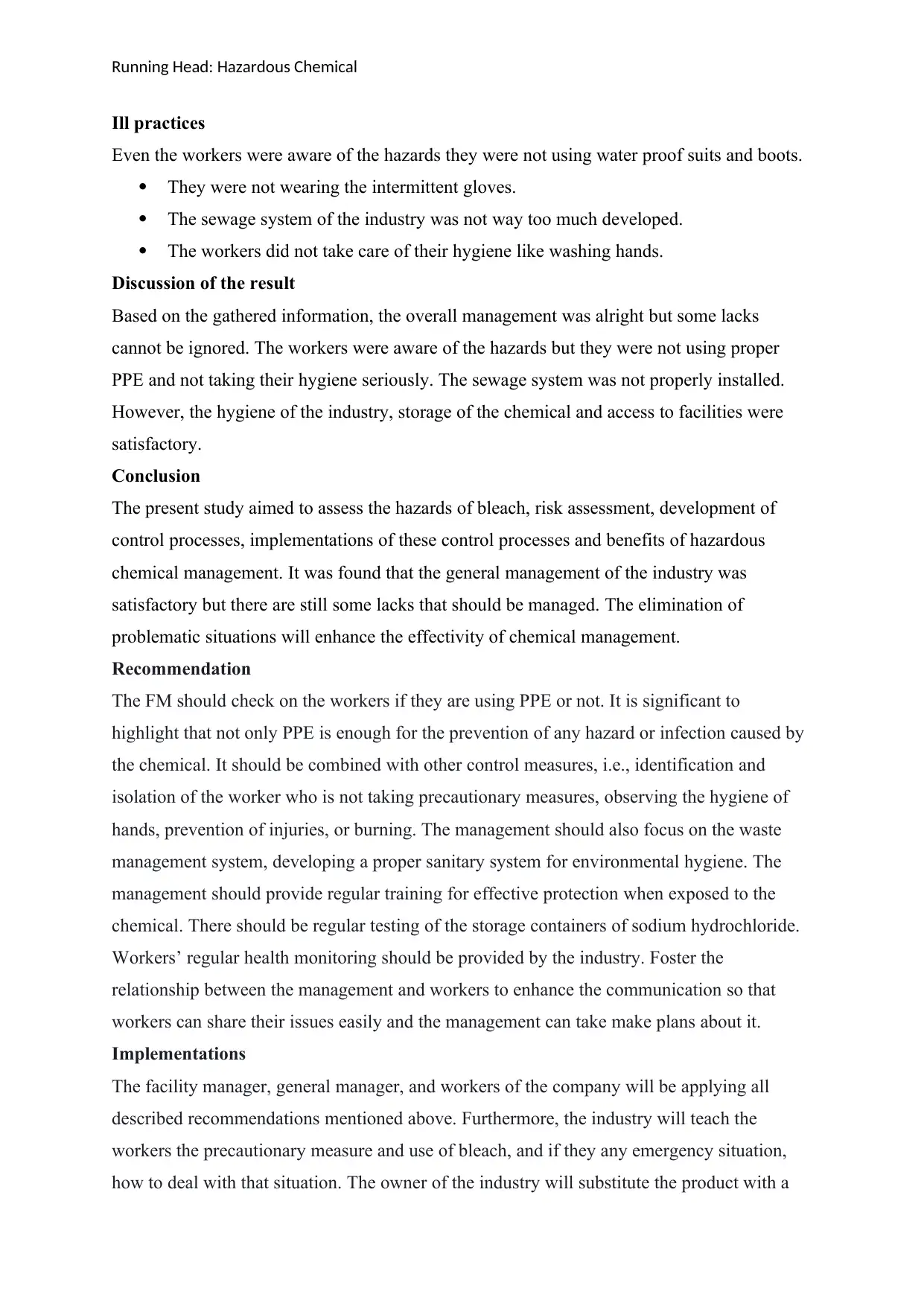
Running Head: Hazardous Chemical
Ill practices
Even the workers were aware of the hazards they were not using water proof suits and boots.
They were not wearing the intermittent gloves.
The sewage system of the industry was not way too much developed.
The workers did not take care of their hygiene like washing hands.
Discussion of the result
Based on the gathered information, the overall management was alright but some lacks
cannot be ignored. The workers were aware of the hazards but they were not using proper
PPE and not taking their hygiene seriously. The sewage system was not properly installed.
However, the hygiene of the industry, storage of the chemical and access to facilities were
satisfactory.
Conclusion
The present study aimed to assess the hazards of bleach, risk assessment, development of
control processes, implementations of these control processes and benefits of hazardous
chemical management. It was found that the general management of the industry was
satisfactory but there are still some lacks that should be managed. The elimination of
problematic situations will enhance the effectivity of chemical management.
Recommendation
The FM should check on the workers if they are using PPE or not. It is significant to
highlight that not only PPE is enough for the prevention of any hazard or infection caused by
the chemical. It should be combined with other control measures, i.e., identification and
isolation of the worker who is not taking precautionary measures, observing the hygiene of
hands, prevention of injuries, or burning. The management should also focus on the waste
management system, developing a proper sanitary system for environmental hygiene. The
management should provide regular training for effective protection when exposed to the
chemical. There should be regular testing of the storage containers of sodium hydrochloride.
Workers’ regular health monitoring should be provided by the industry. Foster the
relationship between the management and workers to enhance the communication so that
workers can share their issues easily and the management can take make plans about it.
Implementations
The facility manager, general manager, and workers of the company will be applying all
described recommendations mentioned above. Furthermore, the industry will teach the
workers the precautionary measure and use of bleach, and if they any emergency situation,
how to deal with that situation. The owner of the industry will substitute the product with a
Ill practices
Even the workers were aware of the hazards they were not using water proof suits and boots.
They were not wearing the intermittent gloves.
The sewage system of the industry was not way too much developed.
The workers did not take care of their hygiene like washing hands.
Discussion of the result
Based on the gathered information, the overall management was alright but some lacks
cannot be ignored. The workers were aware of the hazards but they were not using proper
PPE and not taking their hygiene seriously. The sewage system was not properly installed.
However, the hygiene of the industry, storage of the chemical and access to facilities were
satisfactory.
Conclusion
The present study aimed to assess the hazards of bleach, risk assessment, development of
control processes, implementations of these control processes and benefits of hazardous
chemical management. It was found that the general management of the industry was
satisfactory but there are still some lacks that should be managed. The elimination of
problematic situations will enhance the effectivity of chemical management.
Recommendation
The FM should check on the workers if they are using PPE or not. It is significant to
highlight that not only PPE is enough for the prevention of any hazard or infection caused by
the chemical. It should be combined with other control measures, i.e., identification and
isolation of the worker who is not taking precautionary measures, observing the hygiene of
hands, prevention of injuries, or burning. The management should also focus on the waste
management system, developing a proper sanitary system for environmental hygiene. The
management should provide regular training for effective protection when exposed to the
chemical. There should be regular testing of the storage containers of sodium hydrochloride.
Workers’ regular health monitoring should be provided by the industry. Foster the
relationship between the management and workers to enhance the communication so that
workers can share their issues easily and the management can take make plans about it.
Implementations
The facility manager, general manager, and workers of the company will be applying all
described recommendations mentioned above. Furthermore, the industry will teach the
workers the precautionary measure and use of bleach, and if they any emergency situation,
how to deal with that situation. The owner of the industry will substitute the product with a
⊘ This is a preview!⊘
Do you want full access?
Subscribe today to unlock all pages.

Trusted by 1+ million students worldwide
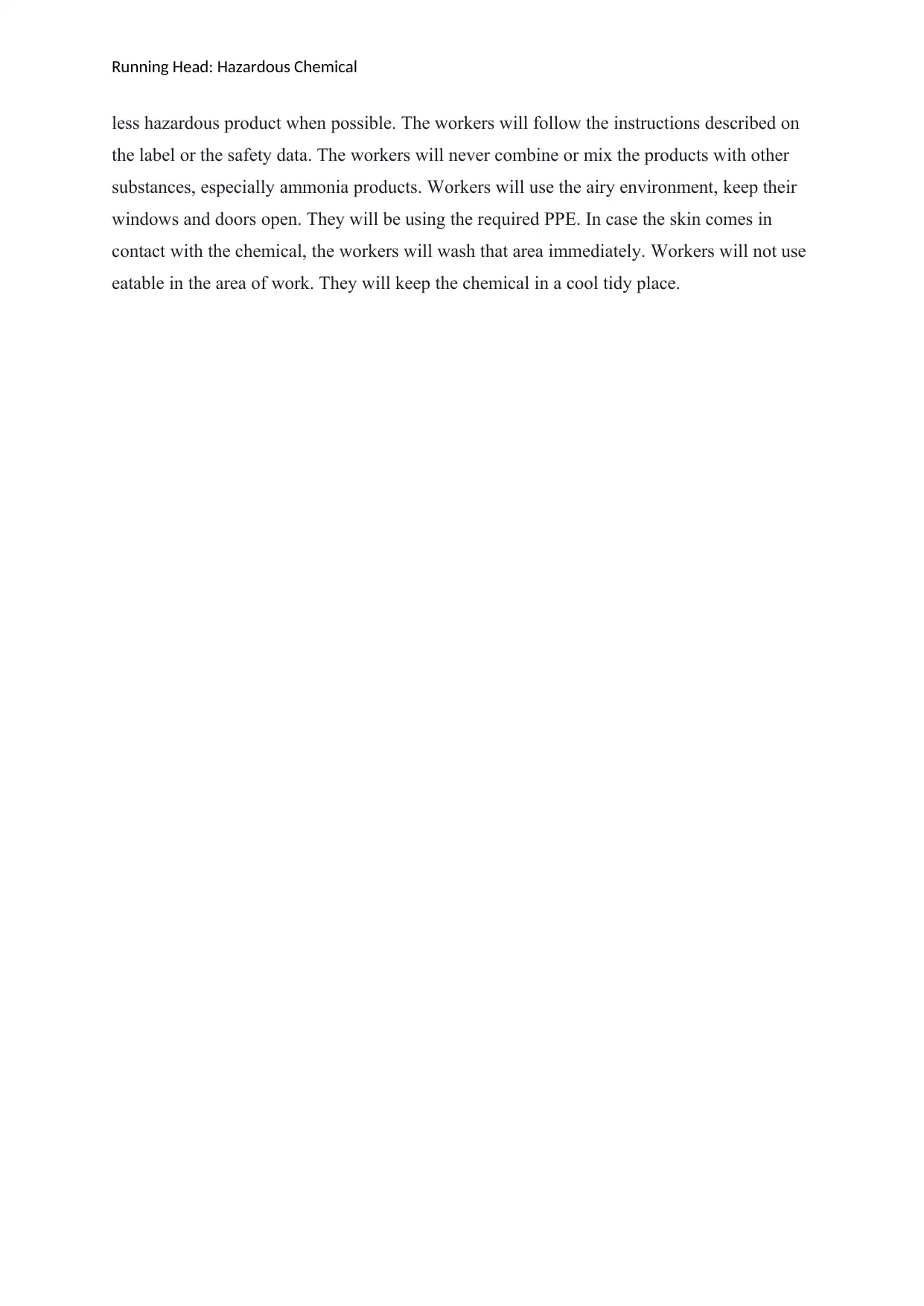
Running Head: Hazardous Chemical
less hazardous product when possible. The workers will follow the instructions described on
the label or the safety data. The workers will never combine or mix the products with other
substances, especially ammonia products. Workers will use the airy environment, keep their
windows and doors open. They will be using the required PPE. In case the skin comes in
contact with the chemical, the workers will wash that area immediately. Workers will not use
eatable in the area of work. They will keep the chemical in a cool tidy place.
less hazardous product when possible. The workers will follow the instructions described on
the label or the safety data. The workers will never combine or mix the products with other
substances, especially ammonia products. Workers will use the airy environment, keep their
windows and doors open. They will be using the required PPE. In case the skin comes in
contact with the chemical, the workers will wash that area immediately. Workers will not use
eatable in the area of work. They will keep the chemical in a cool tidy place.
Paraphrase This Document
Need a fresh take? Get an instant paraphrase of this document with our AI Paraphraser
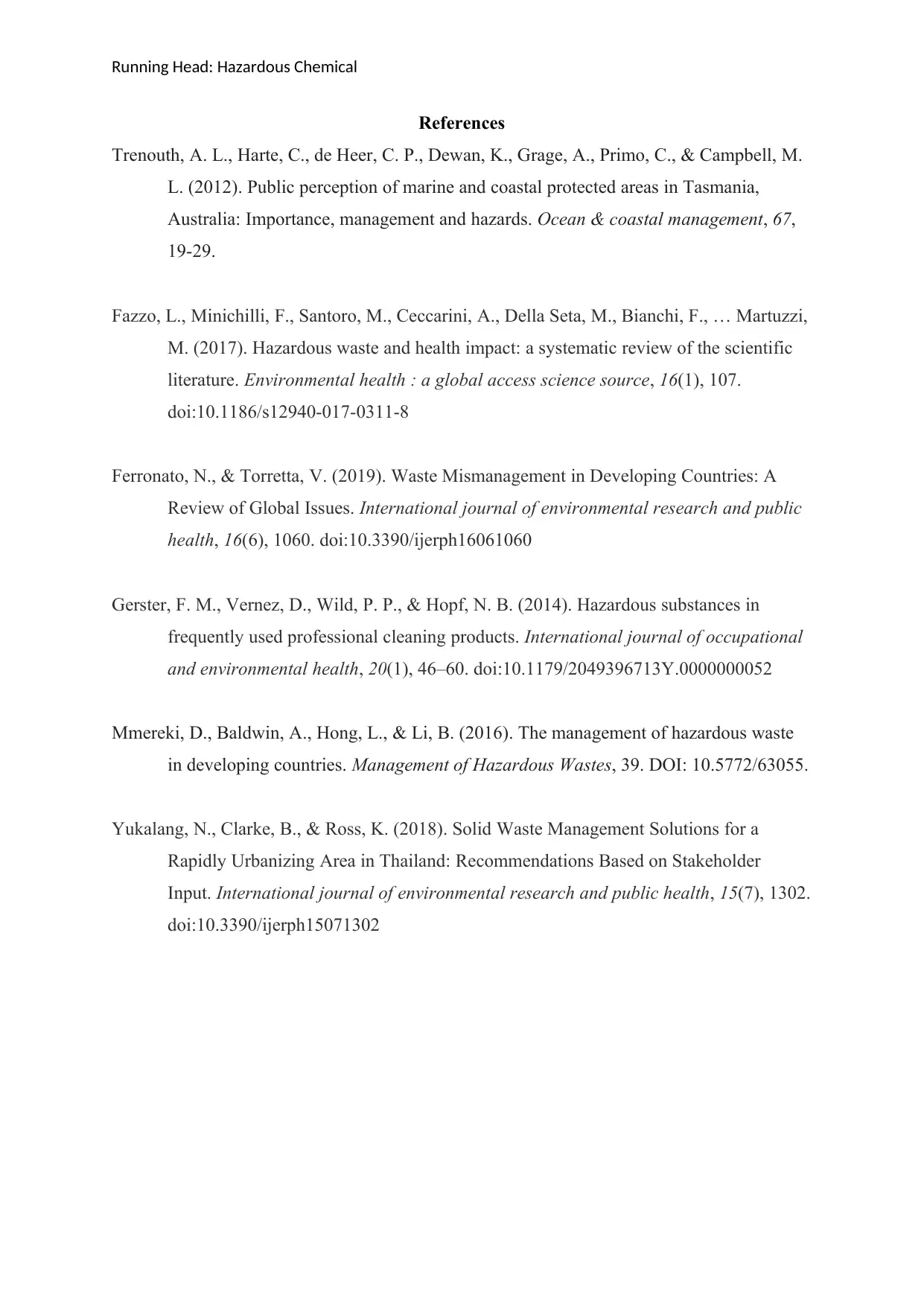
Running Head: Hazardous Chemical
References
Trenouth, A. L., Harte, C., de Heer, C. P., Dewan, K., Grage, A., Primo, C., & Campbell, M.
L. (2012). Public perception of marine and coastal protected areas in Tasmania,
Australia: Importance, management and hazards. Ocean & coastal management, 67,
19-29.
Fazzo, L., Minichilli, F., Santoro, M., Ceccarini, A., Della Seta, M., Bianchi, F., … Martuzzi,
M. (2017). Hazardous waste and health impact: a systematic review of the scientific
literature. Environmental health : a global access science source, 16(1), 107.
doi:10.1186/s12940-017-0311-8
Ferronato, N., & Torretta, V. (2019). Waste Mismanagement in Developing Countries: A
Review of Global Issues. International journal of environmental research and public
health, 16(6), 1060. doi:10.3390/ijerph16061060
Gerster, F. M., Vernez, D., Wild, P. P., & Hopf, N. B. (2014). Hazardous substances in
frequently used professional cleaning products. International journal of occupational
and environmental health, 20(1), 46–60. doi:10.1179/2049396713Y.0000000052
Mmereki, D., Baldwin, A., Hong, L., & Li, B. (2016). The management of hazardous waste
in developing countries. Management of Hazardous Wastes, 39. DOI: 10.5772/63055.
Yukalang, N., Clarke, B., & Ross, K. (2018). Solid Waste Management Solutions for a
Rapidly Urbanizing Area in Thailand: Recommendations Based on Stakeholder
Input. International journal of environmental research and public health, 15(7), 1302.
doi:10.3390/ijerph15071302
References
Trenouth, A. L., Harte, C., de Heer, C. P., Dewan, K., Grage, A., Primo, C., & Campbell, M.
L. (2012). Public perception of marine and coastal protected areas in Tasmania,
Australia: Importance, management and hazards. Ocean & coastal management, 67,
19-29.
Fazzo, L., Minichilli, F., Santoro, M., Ceccarini, A., Della Seta, M., Bianchi, F., … Martuzzi,
M. (2017). Hazardous waste and health impact: a systematic review of the scientific
literature. Environmental health : a global access science source, 16(1), 107.
doi:10.1186/s12940-017-0311-8
Ferronato, N., & Torretta, V. (2019). Waste Mismanagement in Developing Countries: A
Review of Global Issues. International journal of environmental research and public
health, 16(6), 1060. doi:10.3390/ijerph16061060
Gerster, F. M., Vernez, D., Wild, P. P., & Hopf, N. B. (2014). Hazardous substances in
frequently used professional cleaning products. International journal of occupational
and environmental health, 20(1), 46–60. doi:10.1179/2049396713Y.0000000052
Mmereki, D., Baldwin, A., Hong, L., & Li, B. (2016). The management of hazardous waste
in developing countries. Management of Hazardous Wastes, 39. DOI: 10.5772/63055.
Yukalang, N., Clarke, B., & Ross, K. (2018). Solid Waste Management Solutions for a
Rapidly Urbanizing Area in Thailand: Recommendations Based on Stakeholder
Input. International journal of environmental research and public health, 15(7), 1302.
doi:10.3390/ijerph15071302
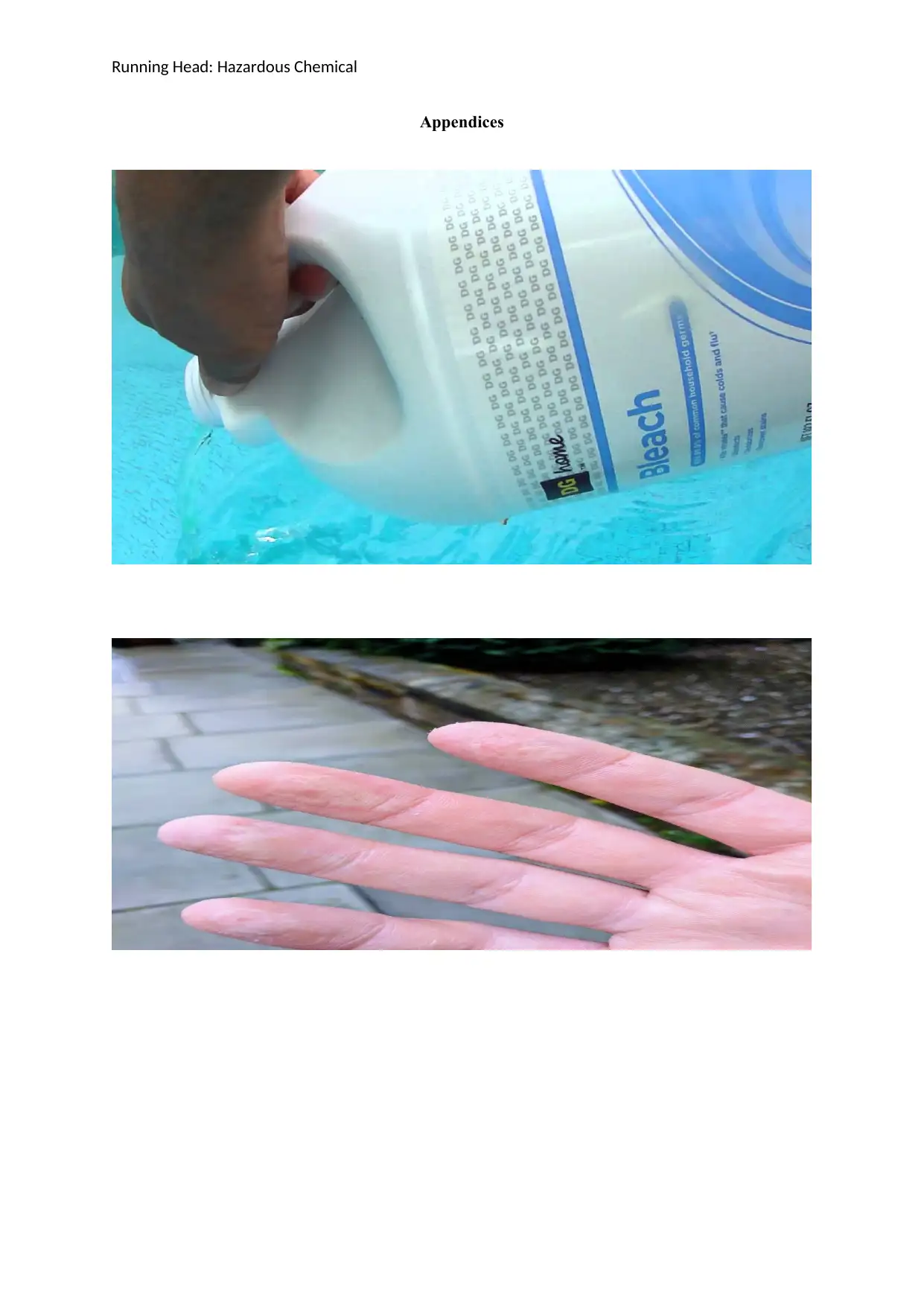
Running Head: Hazardous Chemical
Appendices
Appendices
⊘ This is a preview!⊘
Do you want full access?
Subscribe today to unlock all pages.

Trusted by 1+ million students worldwide
1 out of 14
Related Documents
Your All-in-One AI-Powered Toolkit for Academic Success.
+13062052269
info@desklib.com
Available 24*7 on WhatsApp / Email
![[object Object]](/_next/static/media/star-bottom.7253800d.svg)
Unlock your academic potential
Copyright © 2020–2025 A2Z Services. All Rights Reserved. Developed and managed by ZUCOL.




